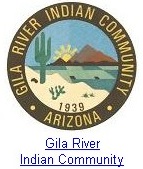
Vision
The Pima-Maricopa Irrigation Project (P-MIP) has developed a unique vision statement. It is unique in that it is a reflection of what the Project sees the Gila River Indian Community looking like in twenty years. (read more)
History
River People by N.E. Allen
The evidence of irrigation here within the Gila River Valley can be scientifically traced to prehistoric times. A civilization evolved about the time the Christian calendar was started and continued for a millennium. Although the evidence of their irrigation system has eroded through time, there are still faint traces which are found. Many of today's projects in the industrial and commercial areas provide these glimpses of the prehistoric past. Huhukam, a name applied to this ancient civilization of prehistoric times, ended around 1450 AD according to scientific evidence.However, just about two hundred years later the Spanish arrived to find people living here in the Gila River Valley with an agricultural system well in place. The Akimel O'othom, or Pima as they are known. Pima was a name given to them by the Spanish, but in their own language they call themselves Akimel O'othom, (river people). We are still here today, still living in the same valley our ancestors did. A belief that is still strong even in this day and age. The only difference today is that we reside on a reservation, the Gila River Indian Community.
Today the Akimel O'othom are in the formative process to establish an irrigation system which will provide water to just over 146,000 acres. A monumental project which has been labeled the Pima-Maricopa Irrigation project (P-MIP). It has just been about two thousand years since the Huhukam began the first irrigation system in North America. Does History repeat itself?
Employment Opportunities
For all Gila River Indian Community employment opportunities, please visit GilaRiver.org Opportunities
The following positions are currently available at GRIIDD:
Civil Engineer (Irrigation)
Equipment Service Worker
Finance Director
Heavy Equipment Operator
Irrigation Delivery Specialist
Mechanic
For information about these GRIIDD positions, please contact:
Jessica Romo, Assistant General Manager
Gila River Indian Irrigation & Drainage District
(520) 562-6786, Direct Office Line
(520) 562-2840, Fax Line
For information about available positions at P-MIP, please contact:
Yvonne Valenzuela, Office Manager
Pima-Maricopa Irrigation Project
(520) 562-6799, Direct Office Line
(520) 562-6791, Fax Line
If your browser will not display these documents,
download the free Acrobat Reader from Adobe:
FTP Sites
 or File Explorer
or File Explorer  in Windows:
in Windows:
ftp://gilariver.com
It should then prompt for a username and password which will be provided to you via e-mail when appropriate. After entering the username and password you should be able to copy and paste files to and from the FTP site.
Contact Information
192-A South "A" Street
P.O. Box C
Sacaton, AZ 85147
Phone: (520) 562-6700
FAX: (520) 562-6791
Gila River Indian Irrigation & Drainage District
192-E South "A" Street
P.O. Box 2202
Sacaton, AZ 85147
Phone: (520) 562-6720
Fax: (520) 562-2840
You can also e-mail P-MIP or GRIIDD











